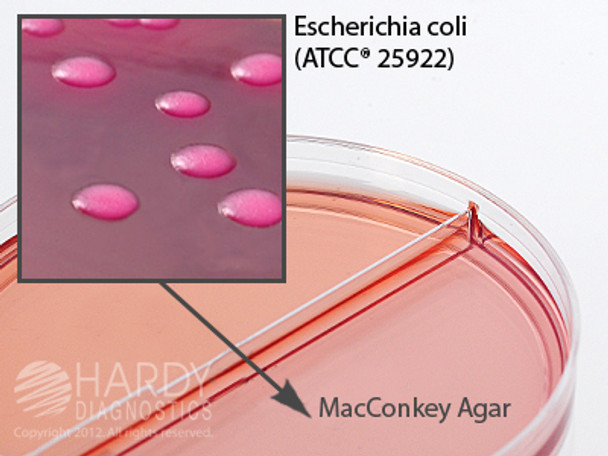Description
CIN Agar/MacConkey Agar with Sorbitol; for Aeromonas, Yersinia, and E. coli O157; 15x100mm biplate, order by the package of 10, by Hardy Diagnostics
Section I: CIN Agar. Section II: MacConkey with Sorbitol.
For isolation of Yersinia, Aeromonas and E. coli O157.
Incubate at 37deg C.
INTENDED USE:
Hardy Diagnostics MacConkey Agar with Sorbitol is to be used as a selective and differential medium for the detection of enterohemorrhagic Escherichia coli O157:H7.
SUMMARY:
E. coli O157:H7 is an enteric pathogen that typically causes hemorrhagic colitis and bloody diarrheal illnesses. It may be followed by hemolytic uremic syndrome, especially in young children. MacConkey Agar with Sorbitol is recommended for isolation of this organism. Rappaport and Henig first described the formulation of the medium, and it was later confirmed by March and Ratham who reported MacConkey Agar with Sorbitol to have a sensitivity of 100% and a specificity of 85%. This medium has proved to be an inexpensive, rapid, simple yet reliable means for the detection of E. coli O157:H7.
FORMULA:
Ingredients per liter of deionized water:* Pancreatic Digest of Gelatin 17.0gm Sorbitol 10.0gm Sodium Chloride 5.0gm Pancreatic Digest of Casein 1.5gm Peptic Digest of Animal Tissue 1.5gm Bile Salts Mixture 1.5gm Neutral Red 30.0mg Crystal Violet 1.0mg Agar 13.5gm Final pH 7.1 +/- 0.2 at 25ºC. * Adjusted and/or supplemented as required to meet performance criteria.
STORAGE AND SHELF LIFE:
Storage: Upon receipt store at 2-8ºC. away from direct light. Media should not be used if there are any signs of deterioration (shrinking, cracking, or discoloration), contamination, or if the expiration date has passed. Product is light and temperature sensitive; protect from light, excessive heat, moisture, and freezing. The expiration dating on the product label applies to the product in its intact packaging when stored as directed. The product may be used and tested up to the expiration date on the product label and incubated for the recommended quality control incubation times.
PRECAUTIONS:
This product may contain components of animal origin. Certified knowledge of the origin and/or sanitary state of the animals does not guarantee the absence of transmissible pathogenic agents. Therefore, it is recommended that these products be treated as potentially infectious, and handle observing the usual universal blood precautions. Do not ingest, inhale, or allow to come into contact with skin. This product is for in vitro diagnostic use only. It is to be used only by adequately trained and qualified laboratory personnel. Observe approved biohazard precautions and aseptic techniques. All laboratory specimens should be considered infectious and handled according to "standard precautions."
PROCEDURE:
Specimen Collection: Consult appropriate references to determine how to correctly collect the specimen to be tested (stool, food, etc.). Method of Use: Allow plates to warm to room temperature. The agar surface should be dry before inoculating. Inoculate the plates with a suspension of the sample to be tested in a dilution small enough to produce isolated colonies. Incubate plates aerobically at 37ºC. for 24 hours. Examine media macroscopically for typical colonies.
INTERPRETATION OF RESULTS:
Colony Morphology: E. coli O157:H7 forms colorless colonies, but otherwise typical of that produced by other E. coli species. Any bacteria capable of fermenting sorbitol (including other E. coli species) form pink colonies on MacConkey Agar with Sorbitol.
LIMITATIONS:
The MacConkey Agar with Sorbitol may be used as an aid in the identification of bacteria. Additional biochemical and/or serological testing using pure culture is recommended for complete identification. Reading of MacConkey Agar with Sorbitol beyond 24 hours should be avoided since the pink color fades in MacConkey Agar with Sorbitol - (SMAC) for the detection of E. coli O157 file:///Z|/hugo/MacConkeySorbitol.htm[2/8/2019 4:15:23 PM] sorbitol-fermenting colonies. Likewise, an extremely heavy inoculum of sorbitol-fermenters may prematurely exhaust the sorbitol and yield white to off-white colonies. Other gram-negative organisms are able to grow on MacConkey Agar with Sorbitol . However, colony appearance is generally enough to differentiate these organisms from E. coli O157:H7. Sorbitol-negative colonies may be presumptively identified as E. coli O157 using our E. coliPRO™ O157 Kit (Cat. no. PL070HD). Further serotyping with H7 antiserum is necessary for definitive identification (Cat. no. 221591).
MATERIALS REQUIRED BUT NOT PROVIDED:
Standard microbiological supplies and equipment such as loops, other culture media, swabs, applicator sticks, incinerators, and incubators, etc., as well as serological and biochemical reagents, are not provided.
QUALITY CONTROL:
Hardy Diagnostics tests each lot of commercially manufactured media using appropriate quality control microorganisms and quality specifications as outlined on the Certificates of Analysis (CofA). The following organisms are routinely used for testing at Hardy Diagnostics: Test Organisms Inoculation Method* Incubation Results Time Temperature Atmosphere Escherichia coli O157:H7 ATCC ® 35150 A 24hr 35°C Aerobic Clear colonies seen; no fermentation of sorbitol Escherichia coli ATCC ® 25922 A 24hr 35°C Aerobic Pink colonies seen; fermentation of sorbitol Enterococcus faecalis ATCC ® 29212 B 24hr 35°C Aerobic Partial to complete inhibition.
PHYSICAL APPEARANCE:
MacConkey Agar with Sorbitol should appear slightly opalescent, and reddish-purple in color.





